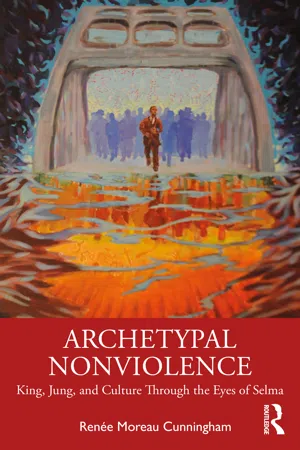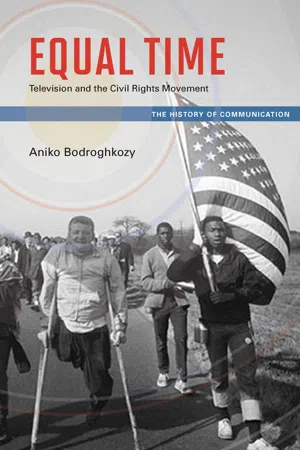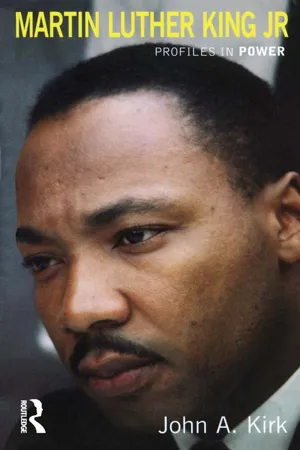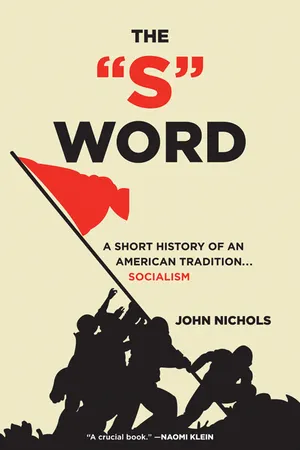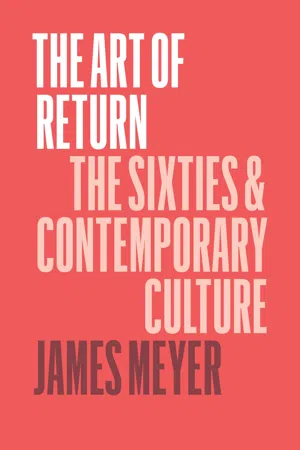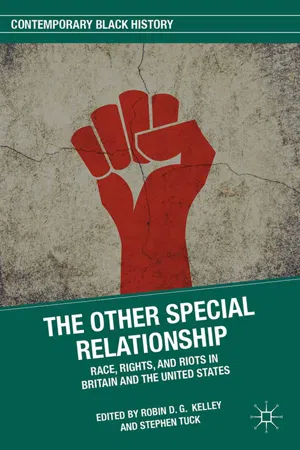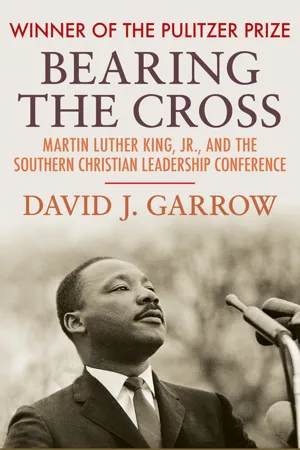History
March on Washington
The March on Washington was a historic civil rights demonstration that took place on August 28, 1963, in Washington, D.C. It was organized to advocate for civil and economic rights for African Americans and included Martin Luther King Jr.'s famous "I Have a Dream" speech. The march is widely recognized as a pivotal moment in the American civil rights movement.
Written by Perlego with AI-assistance
Related key terms
8 Key excerpts on "March on Washington"
- eBook - ePub
Archetypal Nonviolence
Jung, King, and Culture Through the Eyes of Selma
- Renée Moreau Cunningham(Author)
- 2020(Publication Date)
- Routledge(Publisher)
The future of the collective lives in the present of the individual, hard pressed as he is by his problems—which can, in fact, be regarded as the organs of this collective. The sensitive, psychically disturbed and creative people are always the forerunners. Their enhanced permeability by the contents of the collective unconscious, the deep layer which determines the history of happenings in the group, makes them receptive to emerging new contents of which the collective is not yet aware. But these are the people for whom problems become insistent in their personal lives a hundred years or more before the collective has woken up to their existence. (p. 30)Our national suffering unifies us through the marginalized citizenry whose self-chosen few openly grieve and rebel together through the march, demanding a reconciliation for their oppression. Not only in rebellion do they suffer, but through empathy, compassion, and agape, they join together to heal and forge a future filled with the altruistic image of agape-infused peace. Yet, they suffer for they carry the cultural wound at large.Before the marches in Selma, the largest civil rights gathering in American history occurred during the March on Washington, August 28, 1963, when an estimated 250,000 people gathered on the mall to protest the civil injustices being committed against the disenfranchised and to support the Kennedy administration’s passing of the Civil Rights Act, which was being negotiated within Congress (Clayborne Carson, 2001, p. 75). The idea for the march was the result of a dream born twenty years before its manifestation as the dream child of A. Philip Randolph, an African American activist (National Park Service, 2017). Organized by Bayard Rustin, the demonstration began with a mile-long march ending on the mall with a series of speeches, culminating with King’s infamous “I Have a Dream” speech. Indeed, the March on Washington was a dream iterating King’s (2001) vision for a free America, still unfolding today:I say to you today, my friends, so even though we face the difficulties of today and tomorrow, I still have a dream. It is a dream deeply rooted in the American Dream … I have a dream that one day this nation will rise up and live out the true meaning of its creed: “We hold these truths to be self-evident, that all men are created equal.” … I have a dream that my four little children will one day live in a nation where they will not be judged by the color of their skin but by the content of their character. I have a dream today. I have a dream that one day down in Alabama, with its vicious racists, with its governor having his lips dripping with the words of ‘interposition’ and ‘nullification,’ one day right there in Alabama little black boys and black girls will be able to join hands with the little white boys and white girls as sisters and brothers. I have a dream today. (p. 85) - eBook - ePub
The Speech
The Story Behind Dr. Martin Luther King Jr.'s Dream
- Gary Younge(Author)
- 2013(Publication Date)
- Haymarket Books(Publisher)
The historical importance of epoch-defining events like the March on Washington is rarely fully apparent at the time. It is only with the benefit of hindsight that they emerge as emblematic. Yet there was a broad consensus that day that something fundamental and consequential had occurred. Whatever ramifications the march might have for legislation or the movement, the very fact it had taken place, passed without violent incident, and been witnessed by millions was enough. “We’ve come here today to dramatize a shameful condition,” King said in his speech. This was one act America was never going to forget.Karl Marx wrote in The Eighteenth Brumaire of Louis Bonaparte :Men make their own history. But they do not make it as they please; they do not make it under self-selected circumstances, but under circumstances existing already, given and transmitted from the past. The tradition of all dead generations weighs like a nightmare on the brains of the living. And just as they seem to be occupied with revolutionizing themselves and things, creating something that did not exist before, precisely in such epochs of revolutionary crisis they anxiously conjure up the spirits of the past to their service, borrowing from them names, battle slogans, and costumes in order to present this new scene in world history in time-honored disguise and borrowed language.So it was with the March on Washington, which was both bold in its conviction and old in its conception. Bold because national demonstrations in America’s capital were rare at the time. “Marches on Washington have become ritualized dramas, carefully scripted and with few surprises,” writes John D’Emilio inLost Prophet: The Life and Times of Bayard Rustin. “In the decades [since the 1960s] virtually every cause, every constituency, every identity group has descended on the nation’s capital, paraded through its streets, and assembled on the vast Mall to hear an array of speakers and entertainers. . . . This was not the case in 1963. Then the idea was . . . fresh and untried. No one had ever witnessed a mass descent on the nation’s capital.”And it was old because the original idea for such a march had been hatched more than twenty years earlier, by the Black union and civil rights leader Asa Philip Randolph. In 1941 Randolph had called for a March on Washington against discrimination in the defense industry and segregation in the military. “The virtue and rightness of a cause are not alone the condition and cause of its progress and acceptance,” he had argued when announcing the protest. “Power and pressure are at the foundation of the march of social justice and reform. . . . Power and pressure do not reside in the few, and the intelligentsia, they lie in and flow from the masses.” The march was to be Black only. “There are some things Negroes must do alone,” said Randolph. “This is our fight and we must see it through.” - eBook - ePub
Equal Time
Television and the Civil Rights Movement
- Aniko Bodroghkozy(Author)
- 2012(Publication Date)
- University of Illinois Press(Publisher)
46 For a few significant hours, the agenda of a grassroots movement for the empowerment of the disenfranchised and oppressed took over the airways, with TV reporters serving largely as masters of ceremony, sharing in the celebration of consensus.Dayan and Katz provide three basic typologies of media events: contest, conquest, and coronation. The March on Washington was scripted largely as a conquest—the celebration of a charismatic hero struggling against huge odds to bring about significant change. This script emphasizes the primacy of the individualized hero much more than we see in March on Washington coverage, although Dayan and Katz’s typology allows for “collective protagonists.”47In popular memory, of course, the march has become inextricably linked to the figure of Martin Luther King as hero and to King’s “dream” of a world remade. Today, the march is remembered mostly as being about King, with the 250,000 marchers serving largely as audience or backdrop for his charismatic address. This was not how the networks covered the march on August 28. King was not the star of the show: the marchers were the “collective protagonists” along with all the speakers up on the podium, including King. King was in no way privileged. Reporters and commentators did not anticipate his speech or engage in any suspense-building discussion about King’s place in the schedule of events. In this particular version of the “conquest” script, the multitudes accompanying their leaders into the potentially hostile arena were as significant, if not more so, than any charismatic leader. Together with King and the other speakers on the podium at the Lincoln Memorial, they all enacted a script of battle-tested (peaceful) warriors making their pilgrimage to the seat of national power and, against all odds, using the force of their numbers and their collective charismatic quality both to change the world and also to provide a vision of what that changed world would look like. - eBook - ePub
- John A. Kirk(Author)
- 2014(Publication Date)
- Routledge(Publisher)
23 Around two hundred thousand people had packed the area between the Lincoln Memorial and the Washington Monument around the reflecting pool at the heart of the nation’s capital, giving at least the appearance of a united and determined movement with mass support. Importantly, thanks largely to Bayard Rustin’s meticulous preparations and organisational efficiency, the march passed off without any violence and emphasised the discipline and self-control of the demonstrators. This effectively underlined the movement’s contention that it was white oppression and not black activism that had led to unrest in previous southern civil rights campaigns. The interracial element of the march was also significant, with whites comprising around a quarter of all those present. This demonstrated to the nation that the movement did not simply represent the special interests of one section of America, but rather that it had broad-based support. In particular, the involvement of white clergymen from different faiths emphasised the moral dimensions of the struggle. For King, the ‘I Have A Dream’ speech confirmed his status as the leading black spokesperson in the nation.Bayard Rustin, the most important figure in organising the march, poignantly summed up the event by noting that, ‘The march made Americans feel for the first time that we were capable of being truly a nation, that we were capable of moving beyond division and bigotry.’ Being a seasoned activist, Rustin was also aware that ‘The human spirit is like a flame. It flashes up and is gone. And you never know when that flame will come again.’24Back to Birmingham: The Sixteenth Street Church Bombing
The triumph of the March on Washington was swiftly eclipsed by tragedy. On 15 September, Sixteenth Street Baptist Church in Birmingham was hit by a dynamite blast. Four young black girls, Addie Mae Collins, Denise McNair, Carloe Robertson and Cynthia Wesley, who had been attending a Sunday school service, were killed.25 The city exploded with violence as angry blacks confronted the police. Two blacks were shot dead in the ensuing conflict and many others, black and white, sustained injuries. King arrived in Birmingham the same evening in an attempt to bring calm. The following morning, King demanded federal intervention to protect the black community from further white terrorism. Yet although President Kennedy roundly condemned the violence, he shied away from direct federal intervention. King later delivered a moving eulogy at the funeral of the four girls in which he referred to them as ‘the martyred heroines of a holy crusade for freedom and dignity’.26 - eBook - ePub
The "S" Word
A Short History of an American Tradition...Socialism
- John Nichols(Author)
- 2011(Publication Date)
- Verso(Publisher)
The memory of the march, still vivid for those aging Americans who made the trek on the more than 2,000 buses, 21 special trains and ten airliners Rustin enlisted, and maintained to some extent by textbooks that offer a frequently sanitized version of events, has for most Americans softened with the passage of years. There are a great many citizens of good intention and spirit who know only that the Rev. Martin Luther King, Jr., fresh from Georgia’s “Albany Movement” and Alabama’s Birmingham campaign and on his way to Selma and Memphis, electrified the crowd with his declaration: “I have a dream.” But King was not the only speaker on August 28, 1963. After Marian Anderson sang the National Anthem, it was A. Philip Randolph—the fiery young radical champion of the IWW and the anti-colonial struggle, the “most dangerous Negro in America,” the proud Socialist soap-box campaigner for Eugene Victor Debs and the “cooperative commonwealth,” the man who used the threat of a mass mobilization to force the integration of the defense industries of World War II and the threat of a mass refusal to serve to force the integration of the military, now the white-haired counselor of presidents but still a selfdeclared “radical militant”—who opened the program with a call for progress “in service of human needs, not at the service of profits” and a declaration that “private property takes second place to the sanctity of the human personality.”“Fellow Americans,” the seventy-four-year-old Randolph told the crowd massed at precisely the sort of March on Washington he had imagined on that train ride with Milton Webster all those years before, “we are gathered here in the largest demonstration in the history of this nation. Let the nation and world know the meaning of our numbers. We are not a pressure group. We are not an organization or a group of organizations. We are not a mob. We are the advance guard of a massive moral revolution for jobs and freedom.”As the 250,000 Americans cheered, he continued:This revolution reverberates throughout the land, touching every city, every town, every village where black men are segregated, oppressed, and exploited. But this civil rights revolution is not confined to the Negro nor is it confined to civil rights, for our white allies know that they cannot be free while we are not; and we know we have no future in a society in which six million black and white people are unemployed and millions more live in poverty. Nor is the goal of our civil rights revolution merely the passage of civil rights legislation. - eBook - ePub
The Art of Return
The Sixties and Contemporary Culture
- James Meyer(Author)
- 2019(Publication Date)
- University of Chicago Press(Publisher)
Part 3The End of the Sixties
To arrive like this every day for it to be like this to have so many memories and no other memory than these for as long as they can be remembered to remember this.Claudia Rankine, Citizen: An American LyricAugust 2013. It was a sultry day fifty years ago when Martin Luther King Jr. spoke in this place. In the photos of the original march the Reflecting Pool is a blank spot in the middle of the surging crowd, bordered by giant elms heavy with leaves. King smiles and waves at the thousands of marchers gathered at the solemn temple at the edge of the Potomac.Fifty years later, the same weather. The air thick with humidity, a constant sun. The marchers sit on blankets and folding chairs or stand on the unforgiving pavement. We mill about on crabgrass and patches of dirt, and crane our necks to catch a glimpse of the podium. We look at one another with curiosity as we listen to the speakers, and we consider our presence in this place.The organizers of the original march were highly conscious of the twined symbolism of place and time. They held the March on Washington for Jobs and Freedom during the centennial year of the Emancipation Proclamation, held it on the steps of the memorial on whose walls that document is chiseled word for word.1 Inside, the great marble statue of the slain president looks down the pool of water at the obelisk at the top of the hill: the entire sweep of U.S. history, the nation’s unification, fracture, and reunification, its past and future, is embodied in that effigy’s impassive gaze.King was the last of the speakers that day. A century after Lincoln signed his decree, “that great beacon of hope,” millions of people were not truly free, he lamented. Black people were barred from whites-only schools and drinking fountains and obstructed from voting. Too many Americans lived “on an island of poverty” in an “ocean of material prosperity.”2 - eBook - ePub
The Other Special Relationship
Race, Rights, and Riots in Britain and the United States
- R. Kelley, S. Tuck, R. Kelley, S. Tuck, R. Kelley, S. Tuck(Authors)
- 2016(Publication Date)
- Palgrave Macmillan(Publisher)
31 Shortly following Baker’s remarks, film actor Burt Lancaster took to the podium with a scroll of over 1500 names of Americans in Paris who had signed the petition that had circulated in papers throughout Europe in response to James Baldwin’s push for international support of the March on Washington. Although the Paris committee of supporters chose to forego plans to stage a march in Paris, electing instead to demonstrate their solidarity through a collective presentation of their petitions on the afternoon of August 21, 1963, the idea of protesting the second-class citizenship of Black Americans at the thresholds of monuments of American political power would be a theme of the March on Washington movement that would not be lost on international audiences.In the wake of reports that hundreds of protestors organized under the auspices of the multinational African Association were planning a demonstration at the American Embassy in Cairo on the day of the March on Washington, Egyptian officials dispatched over two hundred officers to control the demonstration and prevent protestors from directly surrounding the Embassy so that any “possible embarrassment to U.S.-U.A.R. relations” could be avoided.32 Although only 13 people participated in the march carrying signs displaying such slogans including “Remember Negroes Also Built America,” “Down With US Imperialism,” and “Medgar Evers Did Not Die in Vain,” police intercepted protesters one block away from the embassy and selected two delegates to present their petition to embassy officials.33 Representing nationalist movements in 11 African nations including South Africa, Mozambique, Zimbabwe, and Kenya, the petition, which an embassy official described as being riddled with “Commie-lining phraseology,” railed against the Kennedy Administration “for its pretensions at helping the Negro people” and condemned the “atrocities and barbarities” on display in places like Birmingham, Alabama, “against a people whose only sin is being black, and demanding equality and the enjoyment of elementary human rights.”34 - eBook - ePub
Bearing the Cross
Martin Luther King, Jr., and the Southern Christian Leadership Conference
- David J. Garrow(Author)
- 2015(Publication Date)
- Open Road Media(Publisher)
Despite this success, painful tensions had arisen between ACMHR and SCLC concerning the two organizations’ intertwined financial relationship. ACMHR Treasurer William E. Shortridge complained to Fred Shuttlesworth that their organization was not receiving a fair share of the monies that SCLC was reaping in the wake of the protests. Because Shuttlesworth gave little heed to his repeated complaints, Shortridge took them to SCLC Treasurer Abernathy, explaining that ACMHR had received little income since late May and bills were piling up, especially those from the attorneys and bonding companies that had helped secure the release of the hundreds of demonstrators. Shortridge acknowledged that SCLC had passed along two checks totaling $14,000, but ACMHR was in the red and required further support. King also listened sympathetically to Shortridge during his June 20 visit, but the issue remained a problem throughout the summer.At that evening’s ACMHR mass meeting, King talked about the upcoming pilgrimage to the nation’s capital and how it would put pressure on Congress to pass the civil rights bill that John Kennedy had sent to Capitol Hill just the day before. “As soon as they start to filibuster,” King declared, “I think we should March on Washington with a quarter of a million people.” The next morning, March coordinators Cleveland Robinson and George Lawrence announced plans for the protest to the New York press. The purpose of the mass demonstration, Robinson emphasized, would be to draw national attention to the problem of black unemployment and the need for thousands of new jobs, and not simply to lobby for civil rights legislation.45Within hours of Robinson’s announcement the Kennedy White House summoned the black leadership to a meeting the following day with the president. When the session convened, John Kennedy explained what it would take to win congressional approval of the administration’s bill. The most difficult hurdle would be to obtain cloture in the Senate; for that, the votes of many midwestern Republicans who usually took little interest in racial issues would be necessary. The proposed March on Washington might hinder rather than help the effort to gain those votes. “We want success in Congress,” Kennedy stated,not just a big show at the Capitol. Some of these people are looking for an excuse to be against us. I don’t want to give any of them a chance to say, “Yes, I’m for the bill but I’m damned if I will vote for it at the point of a gun.” It seemed to me a great mistake to announce a March on Washington before the bill was even in committee. The only effect is to create an atmosphere of intimidation—and this may give some members of Congress an out.
Index pages curate the most relevant extracts from our library of academic textbooks. They’ve been created using an in-house natural language model (NLM), each adding context and meaning to key research topics.
